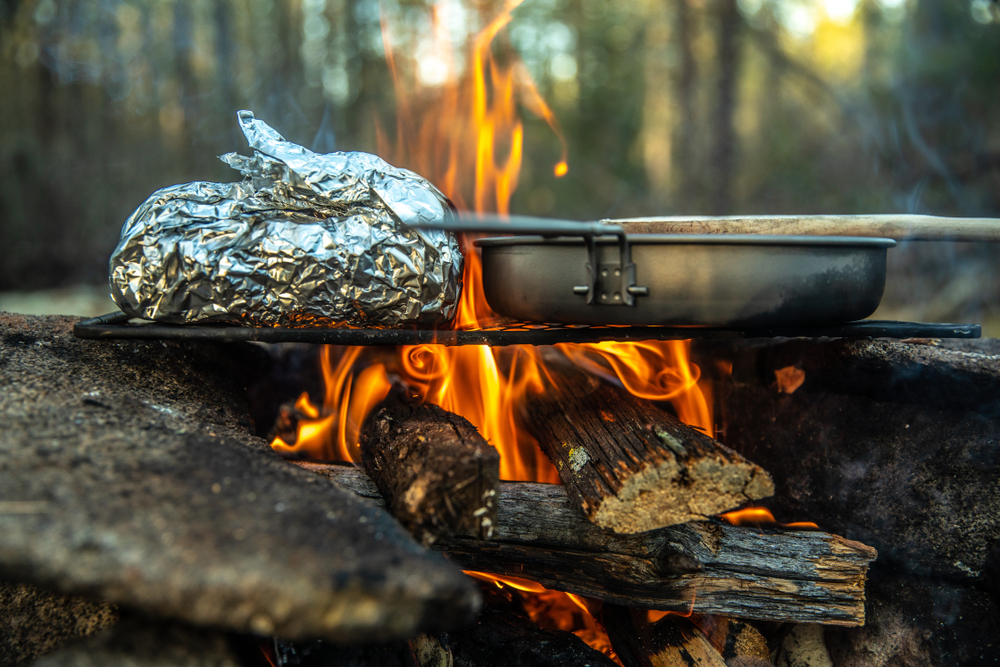Procuring food in the wilderness will always pose a problem for the inexperienced gatherer or hunter, and it may take quite a few tries before they manage to bring something home.
Some hunters will spend thousands of dollars on hunting gear, but how about the average Joe? What happens if you don’t have the skills nor the expensive equipment to help you procure food? Is there some hope, or will you have to go hungry and wait for handouts?
Back in the day, hungry men had to do whatever they could to survive, and while someone managed to live on what the land had to offer, others had to prey on society to feed their loved ones.
For most, food gathering in the wilderness was the only option, and they didn’t need expensive gear to feed their families. With a little bit of preparation and a few necessary tools, they increased their food stockpile every year. Farming, foraging, fishing, and hunting were everyday activities that paid off in the end.
While farming remains one of the most efficient skills to obtain food, we have to remember that agriculture is often subject to Mother Nature’s tempers. There’s never a fail-proof method that can guarantee the success of this year’s crop.
Gathering or foraging is one of humankind’s oldest skills, and exploiting the environment to our advantage had helped people survive when crops were lost, and wars were decimating societies. To be an efficient gatherer, one must have extensive knowledge of the wild edibles residing in their area. No matter if it’s a swamp or a steep hillside, each habitat can provide food to those who know what to look for.
As for fishing and hunting, these are skills that require a lot of experience in the field, and in some instances, one may spend the time he or she may not afford to lose while trying to bag something. You can’t expect to cast a fishing line and reel in something if you don’t know anything about your environment. The same goes for hunting, you can spend an entire day tracking prey, and you may never be able to fire a single shot.
In a survival situation, one must take advantage of what is available, what employs little to no energy to be obtained, and, most importantly, do all the work without complicated and expensive tools.
Survival means having the right skills, the proper tool, but most importantly, the mindset to always improvise with what is available to cover all your basic needs. The tools listed in this article can be found in almost every American household, and our forefathers have used them efficiently to procure foods. These tools are a shovel (preferably a folding one), a cast net, a sweep net, and a trustworthy pellet rifle.
Used individually or together, these tools can help even inexperienced survivalists to obtain food to ensure a proper nutritional intake for the day. Knowing how to use these tools will help you get a certain degree of self-sufficiency and independence when living off the land.
Four simple tools for food gathering
1. Folding shovel
You probably already have one in the trunk of your car, and I bet you’ve never considered it a proper tool for obtaining food. Considering that in the United States, there are more than 150 wild edibles that have easily acquired roots, you may see how such a tool can come in handy.
Here are just a few plants that have edible roots: Yampa, Nutgrass, Cattails, Thistle, Biscuit-root, Common Dock, etc. You will find them in almost any habitat, and they become your main targets when foraging wild edible roots.
Why not gather edibles that require less energy?
In general, edible roots have a much better nutritional value than your common edible greens and other plants. They have a good starch content and complex sugars, and they can provide proper fiber to have good digestion. High in organic compounds, edible roots are ideal for providing a balanced meal in the wilderness.
The only foods better than edible roots are nuts, seeds, and sugary foods. Still, as you can probably imagine, these will not always be available, especially since you are competing for them with the local fauna.
Another advantage of edible roots is that you don’t have to worry about their availability. When the fruiting season is over, getting those sweet sugary fruits will be impossible. However, roots are available year-round and can be easily extracted using your folding shovel.
When digging up edible roots for your next meal, there are a few things you need to keep in mind:
- Every edible root has a unique taste and a specific texture. You will have to cook some of the roots to get rid of that particular taste, while others can be eaten raw.
- If you cannot get used to the taste, you can cook the roots however you desire and mix them with other wild edibles (greens, flowers, fruits, nuts, etc.). I guarantee they will go down smoothly if you do so.
- Check out for parasites and clean the roots properly before cooking them.
- Never dig edible roots from contaminated soil. The roots can absorb a high quantity of chemicals, and you will only get sick if you consume them. Some recommend boiling them at least once before eating the roots. It’s better to be safe than sorry.
Make sure you also know how to use the shovel when digging out the roots. These require some practice, and different soil types, require other methods of extraction. You can thrust the shovel in the ground next to the plant in sandy soil, and the entire plant will be levered out.
However, in soft, muddy soil, you may need to slice the roots since they can develop thickly and grow to a significant length, making the entire plant’s extraction with its root system intact almost impossible.
2. Cast net
A cast net is a simple yet efficient tool to catch aquatic animals. Catching fish is much easier than going after land animals. Finding a body of water is pretty much all you need to test your luck and skills.
A simple six by eight feet cast net can weigh less than five pounds, and you can carry it in your bug-out bag without worrying about the added weight. It pays to have one since you can easily catch various aquatic animals with a single toss. Not to mention that you may also catch some aquatic edible plants beside your main prey.
I’ve mentioned having extensive knowledge about the environment, and I always stress the need to know everything about your living area. Depending on where you live, you can find many nutritious inhabitants of water holes. Every cast of the net can get you small panfish, minnow, crayfish, snails, frogs, and much more.
Regardless of what you catch, it’s essential to know how to cook and eat these aquatic animals. Even more, you should at least have a clue of what nutritional value your catch brings.
I find the cast net to be one of the most useful tools you can bring along in the wilderness. Besides its primary purpose, it can also be used for various survival tasks, such as improvising a quick shelter when the weather suddenly changes.
The problem that most people encounter when using such a tool is the casting action itself. There is a learning curve to it, and even if it seems easy at first, it takes a few tries until you manage to do a throw with the net wide open.
3. Sweeping net
Some of us were chasing butterflies in our younger years and any meadow we could find proved to be an entertaining location. In our uncertain times, the sweeping net can be used to acquire food, and you may be surprised to hear that some of the insects you were catching as a kid are full of fats and proteins. Such insects can provide a nutritional meal when nothing else is available.
Gathering insects is perhaps the simplest and easiest activity that our ancestors used to procure food throughout the year, from late summer, well into the fall. The most valued insects were, and still area, crickets, grasshoppers, and katydids (also known as bush crickets). There can be tens of thousands of insects that are just waiting to be picked in a single field.
I’ve covered the topic of edible insects before, and one of the main issues you have to take care of is the processing of the insects you catch. You need to behead the insects, remove the limbs and the wings as well before cooking them.
Back in the day, there were two mains of cooking the insects. The first and most basic way was to fry them in a pan and add them to other meals, while the second required a little more energy. The insects were gathered in huge quantities, they were fried just a little bit, and then they were crushed into a fine powder. The powder was stored over the winter and added to bread to soups, and even meat dishes.
Using a sweeping net is a pretty basic process, and there are two ways to do it. You could sweep the net through the air and try to catch as many insects as possible, or you can brush the vegetation with it. Sweeping it midair requires some energy, while brushing vegetation requires paying attention to vegetation density and type since you may end up breaking the net. I found the second method to be more rewarding and less energy demanding.
You may have to use the first method when gathering insects that live and thrive near bodies of water. In most cases, you will have your fill form fields long before you get there.
4. Pellet gun
Most of us had a pellet gun when we were young, and we often used it to shoot cans stacked neatly on the fence. We also used it for hunting small animals, but it wasn’t a means of substance but rather a way to perfect our aims.
Today, a high-velocity air rifle can be a trustworthy companion that can help you gather food in the wilderness. Rats, squirrels, birds, lizards, and other small animals could be on your menu if you know how to use a pellet gun.
They may be small in size, and they may be unappealing to some, but they are still food when nothing better is available. Bagging a few squirrels will help keep your family fed long before you manage to bring down that deer you’ve been tracking all day long.
When it comes to buying a pellet rifle, you can pick a single-stroke piston one or the pneumatic pump type. Regardless of the one you chose, you need at least 700 fps velocity if you want to hit targets out to more than 100 feet.
I prefer the .177 caliber because it’s a low-cost and low maintenance one due to its universal distribution. I have the single-stroke type since I find it easier to use while at the same time being more productive than the pump varieties.
One thing that needs to be mentioned is that hunting small game is more complicated than bringing down big game. The little creatures you are targeting are highly elusive animals, and a scope is needed to find them in the dense bush. Not to mention that you need to make each shot count since missing a kill-shot may leave you hungry for the day.
In time, you will improve your accuracy and develop your one-shot, one-kill skill that makes all the difference when running low on pellets.
A final word
The tools listed in the article were at some point in time part of your adulthood, and you’ve probably interacted with them in one way or another. If you find yourself living off the grid, such tools will help you gather food and assure a significant success compared to other food procuring methods.
Using them correctly can help even the novice prepper become an accomplished gatherer or hunter. I honestly believe such tools should be part of any wilderness survival kit since they will provide the extra advantage when food is scarce.














































































Good info as far as it goes. This is the first time I’ve heard talk of edible roots (and I grew up on the land: it was just easier to get food with a gun or fishing rod). It would have helped to know what KINDS of roots are edible or at least which ones to avoid (poisonous or guaranteed to make you sick) if there aren’t many of those. It would also help to know what kind of land we’re discussing finding these roots in (northern woodlands, southern woodlands, desert, prairie, etc.) as only some will be available in any of these areas. If there’s too many, just naming major ones would be more helpful than nothing.
Better to learn how to grow things and raise food. The land is going to be stripped bare by pillagers i 2 years. Game and fish hunted and fished out or the land and shores over run by dufuses all “bugging out.”
You are where you will survive or die. Come to grips with it or live now .
One of the best articles I’ve seen in this space. The info about catching and preparing insects was invaluable! Also, I never thought of a casting net. I’ve always gone to a fishing rod as my default, but you have to hope that the fish are going to bite. If they don’t, you’re screwed. The casting net virtually guarantees that you’re going to bring in something edible with every cast. I think of all those huge carp I’ve seen in the shallows that never want to take the bait. And, I’m going to get some books on wild plants with edible roots. I had no idea that cattails’ roots were edible! I see those things all over the place! Free, easy, food and I never knew! Fantastic piece!
I agree with you 100%, Nuts. Bugging out is stupid, unless you have a well-stocked, secure refuge to go to. That said, however, it’s good to have this sort of knowledge in the event that your home is overrun by looters. Also, I think most of those doofuses who are bugging out are going to kill one another off within a few weeks. They’re all more concerned with their AR-15s and Glocks and body armor and stockpiling ammo, than they are with trying to survive. They want to kill and murder people. There was a discussion where I work about survival preparations. One guy piped up and said, “I don’t have to stockpile anything! I’ll just stick a gun in your ear and take what you have!” Unfortunately, that’s the attitude that most of the “bug-out” crowd has. So, it’s a good idea to know how to survive off the land in the event that you’re forced to do that.